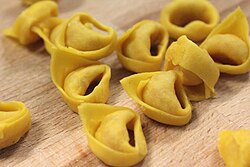Pasta stuffed with filling
.mw-parser-output .hidden-begin{box-sizing:border-box;width:100%;padding:5px;border:none;font-size:95%}.mw-parser-output .hidden-title{font-weight:bold;line-height:1.6;text-align:left}.mw-parser-output .hidden-content{text-align:left}@media all and (max-width:500px){.mw-parser-output .hidden-begin{width:auto!important;clear:none!important;float:none!important))You can help expand this article with text translated from
the corresponding article in Italian. (June 2024) Click [show] for important translation instructions.
View a machine-translated version of the Italian article.
Machine translation, like
DeepL or
Google Translate, is a useful starting point for translations, but translators must revise errors as necessary and confirm that the translation is accurate, rather than simply copy-pasting machine-translated text into the English Wikipedia.
Do not translate text that appears unreliable or low-quality. If possible, verify the text with references provided in the foreign-language article.
You must provide
copyright attribution in the
edit summary accompanying your translation by providing an
interlanguage link to the source of your translation. A model attribution edit summary is Content in this edit is translated from the existing Italian Wikipedia article at [[:it:Tortellini]]; see its history for attribution.
You may also add the template ((Translated|it|Tortellini)) to the
talk page.
For more guidance, see
Wikipedia:Translation.
Tortellini is a type of stuffed pasta typical of the Italian cities of Bologna and Modena. Traditionally it is stuffed with a mix of meat (pork loin, raw prosciutto, mortadella), Parmesan cheese, egg and nutmeg and served in capon broth (in brodo di cappone).[1]
In the area of origin it is usually sold fresh or home-made. Industrially packaged, dried, refrigerated, or frozen tortellini appear in many locations around the world, especially where there are large Italian communities.
Origins
The origin of tortellini is disputed; both Bologna and Modena, cities in Italy's Emilia-Romagna region, claim to be its birthplace.[2] The etymology of tortellini is the diminutive form of tortello, itself a diminutive of torta (lit. 'cake' or 'pie').[3]
The recipe for a dish called tortelletti appears in 1570 from Bartolomeo Scappi. Vincenzo Tanara's writings in the mid-17th century may be responsible for the pasta's renaming to tortellini. In the 1800s, legends sprang up to explain the recipe's origins, offering a compromise. Castelfranco Emilia, located between Bologna and Modena,[2] is featured in one legend, in which Venus stays at an inn. Overcome by her beauty, the innkeeper spies on her through a keyhole, through which he can only see her navel. He is inspired to create a pasta in this shape. This legend would be at the origin of the term ombelico di Venere (lit. 'Venus' navel'), occasionally used to describe tortellini.[4] In honour of this legend, an annual festival is held in Castelfranco Emilia.[5] Another legend posits that the shape comes from Modena's architecture, which resembles a turtle.[6]
Comparison with tortelloni
Tortelloni is pasta in a similar shape, but larger, typically 5 g, vs. 2 g for tortellini.[7] While tortellini has a meat-based filling, tortelloni is filled with ricotta and sometimes with parsley or spinach. Moreover, while tortellini is traditionally cooked in and served with broth, tortelloni is cooked in water, stir-fried (traditionally with butter and sage) and served dry.


